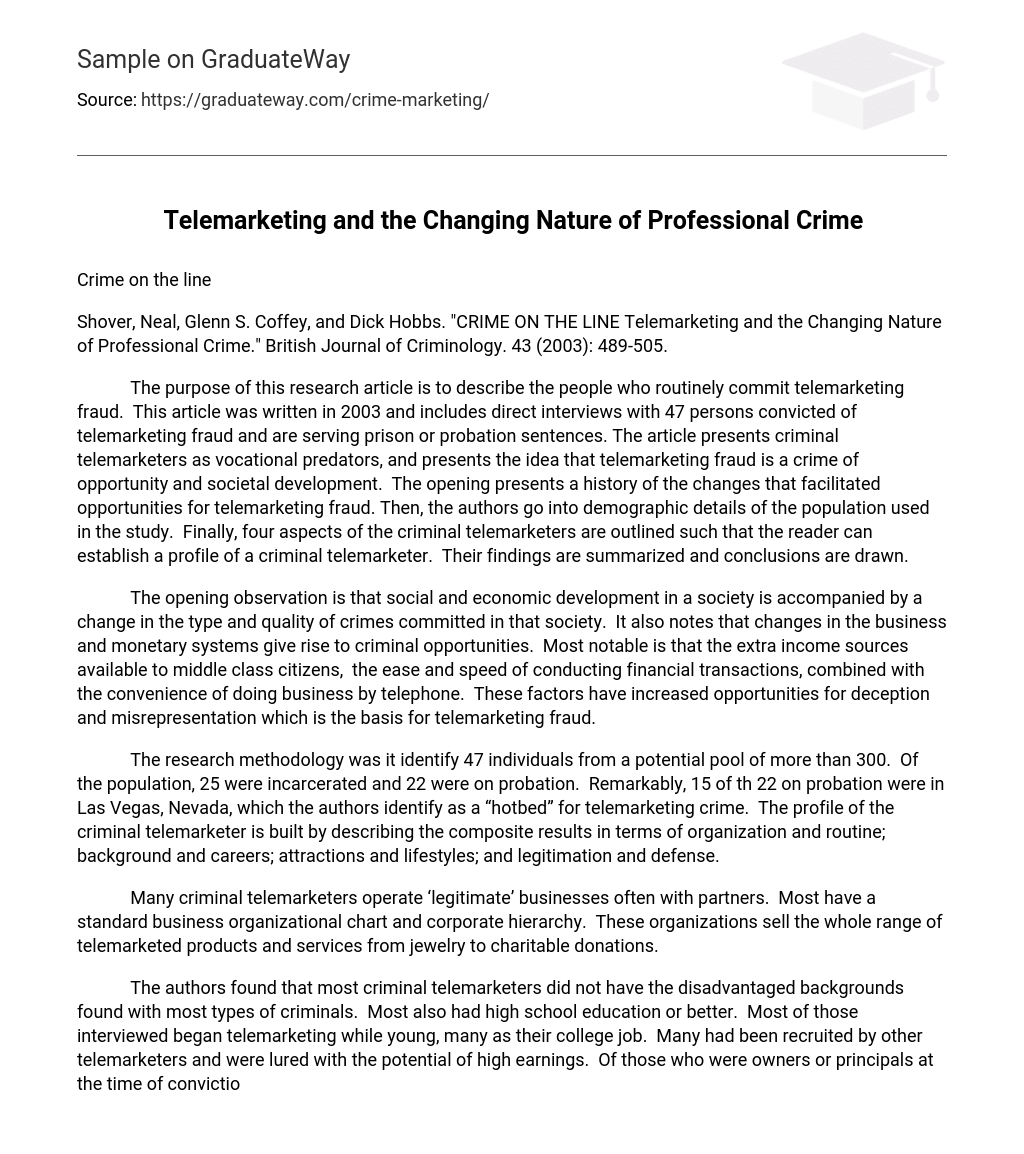Crime on the line
Shover, Neal, Glenn S. Coffey, and Dick Hobbs. “CRIME ON THE LINE Telemarketing and the Changing Nature of Professional Crime.” British Journal of Criminology. 43 (2003): 489-505.
The purpose of this research article is to describe the people who routinely commit telemarketing fraud. This article was written in 2003 and includes direct interviews with 47 persons convicted of telemarketing fraud and are serving prison or probation sentences. The article presents criminal telemarketers as vocational predators, and presents the idea that telemarketing fraud is a crime of opportunity and societal development. The opening presents a history of the changes that facilitated opportunities for telemarketing fraud. Then, the authors go into demographic details of the population used in the study. Finally, four aspects of the criminal telemarketers are outlined such that the reader can establish a profile of a criminal telemarketer. Their findings are summarized and conclusions are drawn.
The opening observation is that social and economic development in a society is accompanied by a change in the type and quality of crimes committed in that society. It also notes that changes in the business and monetary systems give rise to criminal opportunities. Most notable is that the extra income sources available to middle class citizens, the ease and speed of conducting financial transactions, combined with the convenience of doing business by telephone. These factors have increased opportunities for deception and misrepresentation which is the basis for telemarketing fraud.
The research methodology was it identify 47 individuals from a potential pool of more than 300. Of the population, 25 were incarcerated and 22 were on probation. Remarkably, 15 of th 22 on probation were in Las Vegas, Nevada, which the authors identify as a “hotbed” for telemarketing crime. The profile of the criminal telemarketer is built by describing the composite results in terms of organization and routine; background and careers; attractions and lifestyles; and legitimation and defense.
Many criminal telemarketers operate ‘legitimate’ businesses often with partners. Most have a standard business organizational chart and corporate hierarchy. These organizations sell the whole range of telemarketed products and services from jewelry to charitable donations.
The authors found that most criminal telemarketers did not have the disadvantaged backgrounds found with most types of criminals. Most also had high school education or better. Most of those interviewed began telemarketing while young, many as their college job. Many had been recruited by other telemarketers and were lured with the potential of high earnings. Of those who were owners or principals at the time of conviction had started out as phone salespersons, moved up to management, and eventually began their own companies using a similar business model to the companies they had previously worked at. It is also remarkable that many of those convicted telemarketers also had prior drug related offenses in their criminal histories.
Nearly all of the interviewees stated that they wanted the high earnings that would accommodate their lifestyles. The average age of the criminal telemarketers was 42, and as they got older they wanted more traditional lifestyles. But their leisure related consumption remained high. Many believed that their activities were legitimate. Several stated that the victims were willing participants because as consumers they did not read the fine print or conduct due diligence prior to doing business with these telemarketers.
The authors’ conclusion of criminal telemarketers include descriptions of respectable predators and hustlers. They conclude that their legitimate business skills have allowed these telemarketers to “vocationally exploit criminal opportunities.” The conclusion from the article is that criminal fraudulent telemarketers are a creation of the times and circumstances that have grown out of the social, political, and economic evolution of society.
The first similarity between the articles are the titles, “Crime on the Line” (COTL) and “Annoyances on the Line” (AOTL). Both articles discuss penalties associated with the wrong type of telemarketing activities – fines, probation, prison sentences. Both articles state that something is wrong and being done incorrectly on the part of the telemarketing industry. Neither article, however, gives the victims direct response either to the crime resulting from telemarketing or to the simple annoyance of telemarketers.
COTL gives the telemarketer’s perspective and response to the crime factor in telemarketing. AOTL gives the author’s perspective and a consultant’s assessment of the victims view of telemarketing violations. COTL profiles the people who commit the crimes through documented interviews with convicted criminals. AOTL profiles the activities that constitute wrongdoing in telemarketing through the author’s undocumented research. COTL is an academic research paper using scientific methodology to identify the test/interview population and draw a conclusion. It discusses the personal characteristics that turn some telemarketers into criminals. AOTL is a news information article that weaves fact and personal opinion together. It describes the technological issues that turn telemarketing into a non-criminal nuisance.
The USA Today article demonstrates how the further evolution of technology, combined with existing laws reduces the opportunities for criminal telemarketing activities. With automated systems the caller or the recipient of the call is in control. There is no live person to exert the power that many of the 47 convicted criminal telemarketers described in the research article. Recalling and drawing from the statements and conclusions from the first article, as technology changes, the quality of telemarketing fraud and crimes will also change.
Works Cited
“Annoyance on the line.” USA Today 27 Nov. 2007: 11a.
Shover, Neal, Glenn S. Coffey, and Dick Hobbs. “CRIME ON THE LINE Telemarketing and the Changing Nature of Professional Crime.” British Journal of Criminology. 43 (2003): 489-505.





